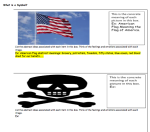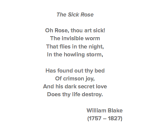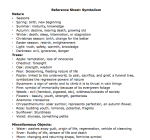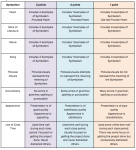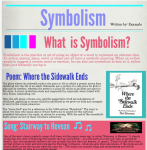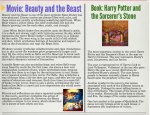Background and Rationale
The purpose of this lesson is for students to develop a concrete understanding of symbolism. Symbolism is when the author uses an object or reference to add deeper meaning to a story. Symbolism in literature can be subtle or obvious, used sparingly or heavy-handedly. An author may repeatedly use the same object to convey deeper meaning or may use variations of the same object to create an overarching mood or feeling. Symbolism is often used to support a literary theme in a subtle manner. Students need to understand that writers insert symbols into their writing to allude to a feeling, mood or attitude without directly stating the perspective or mood. Symbolism is supplemental to the story.
This is a three-day lesson that explores the use of symbolism in spoken, written, graphic, and other visual forms. Students will analyze images, poems, songs, and works of literature that have examples of symbolism. Students will create either an Online Presentation using: Prezi, Slideshark or Screencast; Concept Map: Cacoo; Online Cartoonr: ToonDoon; or Online Poster: PiktoChart representing Symbolism in the following four categories: poem, movie, song and work of literature.
Students will be exposed to a variety of materials in this lesson to keep them engaged. Materials are differentiated based on students abilities. The differentiation includes: Audio and Visual examples, Powerpoint simplified terminology; Class discussion; Graphic Organizers, Reference Sheets, and Google Docs and Class Blog.
Unit Goals
- To examine the use of symbolism in everyday life and literature.
- By studying provided examples, as well as studying their own personal choices, students come to understand that a symbol is a representation of a bigger idea or “truth.”
Unit Objectives
-
Analyze images representing symbolism and list the abstract ideas associated with each image on the Google Doc. with 80% accuracy.
-
List feelings and emotions associated with each image on the Google Doc graphic organizer with 100% accuracy.
-
Define symbolism in written form with 100% accuracy.
-
Analyze the poem The Sick Rose and identify four examples of symbolism with 85% accuracy.
-
Create 1 of the following:
-
Online Presentation: Prezi, Slideshark or Screencast;
-
Concept Map: Cacoo;
-
Online Cartoonr: ToonDoon; or
-
Online Poster: PiktoChart.
-
Identifying and explaining two examples of symbolism in a poem, a piece of literature, a movie and a song with 80% accuracy.
Lesson Objectives
Objective |
Bloom’s Verb |
|---|---|
|
Analyze images representing symbolism and list the abstract ideas associated with each image on the Google Doc. with 80% accuracy |
Analyzing |
|
List feelings and emotions associated with each image on the Google Doc graphic organizer with 100% accuracy. |
Remembering |
|
Define symbolism in written form with 100% accuracy. |
Remembering |
|
Analyze the poem The Sick Rose and identify four examples of symbolism with 85% accuracy |
Analyzing |
|
Creating: Create 1 of the following:
|
Creating |
|
Identifying and explaining two examples of symbolism in a poem, a piece of literature, a movie and a song with 80% accuracy. |
Understanding |
Bloom’s Taxonomy
Creating (highest level)
Common Core / State and District Standards
-
CCSS.ELA-Literacy.RL.7.2 Determine a theme or central idea of a text and analyze its development over the course of the text; provide an objective summary of the text.
-
CCSS.ELA-Literacy.SL.7.1 Engage effectively in a range of collaborative discussions (one-on-one, in groups, and teacher-led) with diverse partners on grade 7 topics, texts, and issues, building on others’ ideas and expressing their own clearly.
-
CCSS.ELA-Literacy.SL.7.5 Include multimedia components and visual displays in presentations to clarify claims and findings and emphasize salient points.
Technology Integration (ISTE Standards•S)
Creativity and innovation
Students demonstrate creative thinking, construct knowledge, and develop innovative products and processes using technology.
- Apply existing knowledge to generate new ideas, products, or processes
Communication and collaboration
Students use digital media and environments to communicate and work collaboratively, including at a distance, to support individual learning and contribute to the learning of others.
- Interact, collaborate, and publish with peers, experts, or others employing a variety of digital environments and media
- Communicate information and ideas effectively to multiple audiences using a variety of media and formats
- Contribute to project teams to produce original works or solve problems
Research and information fluency
Students apply digital tools to gather, evaluate, and use information.
- Locate, organize, analyze, evaluate, synthesize, and ethically use information from a variety of sources and media
- Evaluate and select information sources and digital tools based on the appropriateness to specific tasks
Critical thinking, problem solving, and decision making
Students use critical thinking skills to plan and conduct research, manage projects, solve problems, and make informed decisions using appropriate digital tools and resources.
- Plan and manage activities to develop a solution or complete a project
Learning and Innovation Skills (P21.org)
Creativity and innovation
Think Creatively:
-
Use a wide range of idea creation techniques (such as brainstorming)
-
Create new and worthwhile ideas (both incremental and radical concepts)
-
Elaborate, refine, analyze and evaluate their own ideas in order to improve and maximize creative efforts
Work Creatively with Others:
-
Develop, implement and communicate new ideas to others effectively
-
Be open and responsive to new and diverse perspectives; incorporate group input and feedback into the work
Reason Effectively:
-
Use various types of reasoning (inductive, deductive, etc.) as appropriate to the situation
-
Use Systems Thinking
-
Analyze how parts of a whole interact with each other to produce overall outcomes in complex systems
-
Make Judgements and Decisions
-
Effectively analyze and evaluate evidence, arguments, claims and beliefs
-
Analyze and evaluate major alternative points of view
-
Synthesize and make connections between information and arguments
-
Interpret information and draw conclusions based on the best analysis
Communicate Clearly
-
Articulate thoughts and ideas effectively using oral, written and nonverbal communication skills in a variety of forms and contexts
-
Utilize multiple media and technologies, and know how to judge their effectiveness a priori as well as assess their impact
-
Listen effectively to decipher meaning, including knowledge, values, attitudes and intentions
-
Use communication for a range of purposes (e.g. to inform, instruct, motivate and persuade)
Information, Media, and Technology Skills (P21.org)
Access and Evaluate Information
-
Access information efficiently (time) and effectively (sources)
-
Evaluate information critically and competently
Create Media Products
-
Understand and utilize the most appropriate media creation tools, characteristics and conventions
Apply Technology Effectively
Use technology as a tool to research, organize, evaluate and communicate information
Life and Career Skills (P21.org)
Manage Goals and Time
-
Set goals with tangible and intangible success criteria
Be Self-directed Learners
-
Go beyond basic mastery of skills and/or curriculum to explore and expand one’s own learning and opportunities to gain expertise
Materials
-
Powerpoint Symbolism PPT
-
Student Handout Symbols Doc.
-
Homework HW
-
Links to: https://todaysmeet.com
Thinking Routine
Connect Extend Challenge (See Below)
The purpose of this routine is to connect new ideas to prior knowledge. This routine provides a space and structure where new thinking is visual to help students connect new ideas about symbolism with ones that they already have. It will also allow students to reflect upon how they have broadened their thinking and find what challenges them or their thinking about symbolism. This strategy will demonstrate to the students that ideas and information can connect to other subjects and topics that they already know. This will allow the student to think in new ways or to question assumptions.
Lesson – Introduction
Students will be given a Google Doc with examples depicting four images (American Flag, Olympic Rings, Poison Skull, and the Macintosh Apple) that represent symbolism.
The purpose of this activity is to tap into student’s prior knowledge, allowing them to think about symbolism and how it relates to them in a real world setting. I will model the first image of the American Flag for the students on the Smartboard so that they have a clear understanding of expectations. Students will then independently analyze the images and list the abstract ideas associated with each image in the graphic organizer. Students will type their feelings and emotions associated with each image.
After Students have completed the graphic organizer on Google Doc the class will share responses and their interpretations. This will allow the teacher to see their current understandings of symbolism.
Lesson Procedures and Activities
Day 1 of the lesson on symbolism:
Powerpoint:
-
Students will be shown a Powerpoint that provides a definition of symbolism; why symbolism is used; examples and meanings; and why symbols were created. Students will take notes based on the power point. Skeletal notes will be provided for special education students. (See Powerpoint)
-
If students still need additional reinforcement this YouTube Video is a great resource:
-
After the Powerpoint presentation students will participate in the Thinking Routine: Connect Extend Challenge.
Thinking Routine: Connect Extend Challenge
The purpose of this routine is connecting new ideas to prior knowledge. This routine provides a space and structure where new thinking can be visual to help students connect new ideas about symbolism with ones that they already have. It will also the student to reflect upon how they have broadened their thinking and find what challenges them or their thinking about symbolism. This strategy will demonstrate to the students that ideas and information can connect to other subjects and topics that they already know. This will allow the students to think in new ways or question assumptions.
A large piece of chart paper will be hanging on the wall in the classroom. Each student will be provided post-it notes. Students and will write their responses on the post-it to the questions listed below and post them on the class chart. The three questions they will respond to are:
-
How are the ideas/information presented connected to what you already knew about symbolism?
-
What new ideas did you get that extended or broadened your thinking in new directions about symbolism?
-
What challenges or puzzles have come up in your mind from the ideas and information presented about symbolism?
Closure Lesson #1 : Students will be asked to complete an exit card by defining what symbolism means.
Homework: Symbolism Worksheet Google Doc is a formative assessment to gauge students understanding of the lesson.
Day 2 of the lesson on symbolism: Symbolism in Poetry
Symbolism in William Blake’s poem the “The Sick Rose”
-
Review key tenets of symbolism with students. Introduce to the students, that today as a class we will be analyzing William’s Blake’s poem “The Sick Rose” for symbolism.
-
Give the students the analogy that symbols are like stones that have been tossed into the water creating ripples. Each ripple is a different layer of meaning. The more ripples you have around your symbol, the more experience you have in your life and connections you can make to the poetry.
-
The teacher will model the following example: Tiger See handout:
-
Students will be asked to place the word ROSE in the center of their paper. Draw a circle around it. What does a rose mean to you? (………….) Each time you think of a new meaning draw another circle. Students will share out their responses and the teacher will visible display responses on the Smartboard.
-
As a class we will read The Sick Rose. Students will independently complete the chart and share their responses in “Todays Meet”. Todays Meet is a microblogging backchannel that empowers teachers to generate a discussion, without the interference of raised hands or student disruption. Link to set up an online “Twitter “ like chat room through Todays Meet.
-
After students share and read their classmates responses (Think Pair Share Activity.) We will come together as a whole class to discuss the answers.
Symbolism – is an ordinary object, event, person, or animal to which we have attached extraordinary meaning and significance.
1. What might the rose symbolize in this poem? (Think of your warm up.) Rose: a symbol of perfection and the flower of Venus (the Roman goddess of love). It also stands for joy and peace. The rose is always seen as feminine. A red rose can represent life, spring, passion and blood.
2. What other symbols can you pick out? How do they work with/relate to your idea for what the rose symbolizes? (Do some “ripple” brainstorms.)
Possible answers for the following:
|
Worm |
Worm: a symbol of death. It is connected with lowness, vileness and contempt. In this poem, worm is also specifically the canker worm which eats the roots of the rose. |
|
Storm |
Storm: a symbol of chaos, confusion, fear, wildness, destruction and change. The storm can also be seen as blowing away the old and frail and giving the new room to expand. If the storm is seen to have creative effects, there must first be great wildness and destruction. |
|
Night |
Night: a symbol of darkness, of things secret and hidden. It is also a symbol of evil. Satan is referred to as the Prince of Darkness. |
|
Bed |
Bed: a symbol of sleep and the vulnerability and innocence of sleep. In this poem it is also, of course, a garden bed. |
Day 3 of the lesson on symbolism: Symbolism Project
PROJECT: SYMBOLISM is all around us.
Symbolism in Poetry, Literature, Movies and Songs.
-
Students will be introduced and explained the expectations of the Symbolism is all around us project.
-
Students will create 1 of the following:
-
Online Presentation: Prezi, Slideshark or Screencast;
-
Concept Map: Cacoo;
-
Online Cartoonr: ToonDoon; or
-
Online Poster: PiktoChart.
-
Students will Identify and explain two examples of symbolism in a poem, a piece of literature, a movie and a song with 80% accuracy.
Students need to identify symbolism in each of the following:
o Poem (Provide the poem and a 2 examples of symbolism in the poem)
o Movie (The name of the movie/Visual Picture of the Movie two examples of symbolism)
o Song (Provide the Lyrics/or audio with two examples of symbolism)
o Work of Literature (Name and Author with 2 examples of symbolism)
A list of resources of Poems, Songs, Works of Literature and Movies will be provided. Students will have the opportunity to select other works based on teacher approval.
A reference sheet identifying symbolism in nature, weather, colors will be provided for students abstract concepts to be broken down:
Poems
o “Where the Sidewalk Ends” by Shel Silverstein
o “The Raven” by Edgar Allan Poe
o “The Road Not Taken” by Robert Frost
o My Heart Leaps Up When I Behold by William Wordsworth
o “More Poems” by A. E. Housman
o “A light exists in spring” by Emily Dickinson
o “To the Moon” by Percy Bysshe Shelley
o “Once Upon a Tine “ by Gabriel Okara
*Language of Literature Textbook also has poem with great examples of symbolism.
Movies: Disney Movies
o Snow White,
o The Lion King,
o Toy Story 3,
o Beauty and the Beast,
o The Little Mermaid,
o Cinderella, and
o Aladdin.
Songs
o “Cats in the Cradle”, Harry Chapin
o “I Believe I Can Fly”, Seal
o “Somewhere Over the Rainbow”, Judy Garland
o “I Hope You Dance”, Lee An Womack
o “Long December”, Counting Crows
Books
The following is a link to a list of books that have great examples of symbolism:
http://www.librarything.com/tag/children’s+books,+symbolism
o Alice’s Adventures in Wonderland and Through the Looking… by Lewis Carroll
o Oh, the Places You’ll Go! by Dr. Seuss
o The Chronicles of Narnia by C. S. Lewis
o Stuart Little by E. B. White
o The Wonderful Wizard of Oz by L. Frank Baum
o The Tale of Despereaux by Kate DiCamillo
o The Secret Garden by Frances Hodgson Burnett
o Where the Red Fern Grows by Wilson Rawls
o Grimm’s Complete Fairy Tales by Jacob Grimm
o Charlotte’s Web by E. B. White
o Bridge to Terabithia by Katherine Paterson
o Holes by Louis Sachar
o The Lion, the Witch and the Wardrobe by C. S. Lewis
o A Wrinkle in Time by Madeleine L’Engle
Nursery Rhymes/Fairy Tales
Just about any fairy tales/folktale is going to include some strong symbolism. A quick Google search will assist you with the significance of the animals and setting.
o Goldilocks and the Three Bears
Humpty Dumpty, if you research this online, you will find various interpretations as to who Humpty Dumpty represents. Interesting stuff!
Lesson Closure
Students will take part in the I Used to Think, But now I know….
The purpose of this routine is to start reflecting on how and why our thinking has changed about symbolism. This routine helps students to reflect on their thinking about a topic or issue and explore how and why that thinking has changed. It can be useful in consolidating new learning as students identify their new understandings, opinions, and beliefs. By examining and explaining how and why their thinking has changed, students are developing their reasoning abilities and recognizing cause and effect relationships.
Explain to students that the purpose of this activity is to help them reflect on their thinking about the topic symbolism and to identify how their ideas have changed over time. For instance:
When we began this study of symbolism, you all had some initial ideas about it and what it was all about. In just a few sentences, I want you to write what it is that you used to think about symbolism. Take a minute to think back and then type your response on our class’s Todays Meet .
“ I used to think…”
Now, I want you to think about how your ideas about symbolism have changed as a result of what we’ve been studying/doing/discussing. Again, in just a few sentences, write down what you now think about symbolism.
Start your sentences with, “But now, I think…”
Assessment
 Summative Assessment: Symbolism Project / Rubric. Create 1 of the following:Online Presentation: Prezi, Slideshark or Screencast; Concept Map: Cacoo; Online Cartoonr: ToonDoon; or Online Poster: PiktoChart. Students will identify and explain two examples of symbolism in (1) poem, (1) piece of literature, (1) movie, and (1) song with 80% accuracy.
Summative Assessment: Symbolism Project / Rubric. Create 1 of the following:Online Presentation: Prezi, Slideshark or Screencast; Concept Map: Cacoo; Online Cartoonr: ToonDoon; or Online Poster: PiktoChart. Students will identify and explain two examples of symbolism in (1) poem, (1) piece of literature, (1) movie, and (1) song with 80% accuracy.
Students will be provided with a rubric that will clearly define the expectations for their Symbolism Project. Students will present their Symbols in Projects to the class. Grading will be based upon a rubric.
Formative Assessment: Students will also be assessed through informal observation, on task behavior and oral questioning. Students are to remain on task and participate in all activities.
-
Homework Symbolism
-
Exit Card
-
Graphic Organizer Completion
-
Thinking Routine: Connect Extend Challenge
-
Post on “Todays Meet”
-
The Sick Rose Handout/Chart
-
I use to think…But now I know
Student Work Example
References: Ritchhart, R., Church, M., & Morrison, K. (2011). Making Thinking Visible: How to Promote Engagement, Understanding, and Independence for All Learners. San Francisco, CA: Jossey-Bass. The Sick Rose Handout

